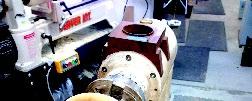
5 minute read
From David Marks Studio
From David Marks Studio Question on Drying Olivewood by David Marks
A quick clarification from David’s column in the January issue. On the day of delivery, a final coat of wax was applied to Metamorphosis in the morning.
Advertisement
David Marks has been a studio furniture maker in Santa Rosa, CA for over 40 years and was the host of the popular woodworking television program WoodWorks on the DIY network. He also has been a contributor to Woodworker West, since 2004. All 91 episodes of the seven seasons of WoodWorks can be purchased as DVDs—by season— or as individual downloadable episodes, from David’s eStore at: www.djmarks.com/estore/. Also available are project plans. David conducts hands-on private classes in his Santa Rosa, CA studio. For info, visit the website: www.djmarks.com/classes/.
Page 36 Drying Olive Wood: I was searching for information on drying Olivewood and found a post on the Internet that you had made. I am a neophyte at drying wood for turning, with most of my "learning experiences" ending up fueling my neighbor's outdoor pizza oven.
I have the opportunity to get some trimmings from an Olive orchard in California’s Livermore Valley.
Your method of soaking rough turned pieces in denatured alcohol to remove water and then resealing with greenwood sealer sounds like something that would work for me.


When the surface has dried after the alcohol bath, you again seal the entire piece with green wood sealer. Will the piece then continue to slowly dry?


Olive Trees in a Northern California Orchard
Another problem for me is the California Air Resources Board has now caused denatured alcohol to be banned in California. Is there a substitute for denatured alcohol, or will I need to do my alcohol bath of Olive wood and drying outside of the state of California? Randy David’s Answer: Your question about drying Olivewood is a good one. I also had an opportunity to get some Olivewood branches from an orchard in Northern California back in 2013, and I have learned that California Olive trees grown in orchards are very unstable. Most of the wood that I harvested cracked even after multiple coats of Anchor seal (liquid wax) and storing it in a cool shed. Unfortunately, it was the year that we had some of the worst droughts—with high temperatures and low humidity—which really hurt my drying process. Based on that experience, I now recommend storing Olivewood underwater, which will do the best job of preserving it until you are ready to rough turn it.
I used to add Clorox bleach to the water to keep it clean, but it melted the outer layer of Maple (which I was able to turn away later). Now, I just let the wood become a swamp and keep it covered with plastic, so mosquitoes don't breed in it.





When you are ready to turn wet Olivewood, it will turn like butter. Rough out the shape to a wall thickness of anywhere between 1" to 1 1
/2" thick. Olivewood distorts like crazy when it dries so it’s advisable to leave the walls a little thicker but not too thick.




This is the least expensive method, so it will save you a lot of money in alcohol. I use a big metal drum (50 gallons or more), which I picked up at a recycling center. I place the drum on some bricks on a concrete surface and use a big propane stove underneath the drum as my heat source. I deposit my roughed out wood inside the drum, and then I fill it up with water. Next, I turn on the heat and bring it to a boil which will take quite a while. I boil the wood for approximately one hour for each inch of wall thickness, though allowing it to stay in longer won't hurt the wood. After it has boiled for a couple of hours, then I turn the heat off and let it cool down overnight. The next day, I use a short piece of garden hose as a siphon to remove the water. I let my bowl blanks and hollow vessel blanks drip dry for a day or two and then cover them with paper bags to slow the down the drying time. After 2 weeks, I remove the paper and just allow the bowl blanks to air dry. If the wall thickness is 1", the wood should start to dry down to 10% moisture content after 2 months or so.
Sealing it with Anchor Seal is also another method, but I don’t apply Anchor Seal after submerging the wood in alcohol. Since you mentioned that California banned denatured alcohol (I had to look it up because it was hard to believe!), then I highly recommend boiling the rough turned blanks in water.



Here is a stack of Olivewood that I double coated with Anchor Seal Wax and stacked & stickered in the traditional way for drying slabs. I also hosed it with water and tarped it to slow down the drying process. Unfortunately, this was back in 2013 when California was having a really bad drought, so the slabs did crack. I figure that I can still have plenty of wood for smaller projects, by cutting away the cracks and harvesting the solid timber.










